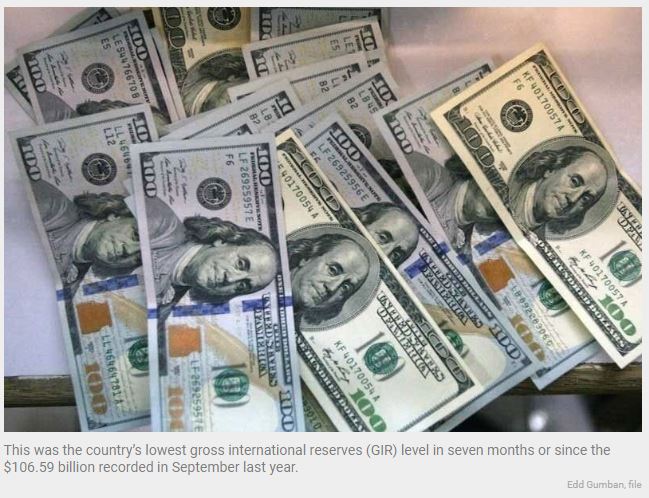Philippines: Forex buffer drops to $106.76 billion in April
MANILA, Philippines — The country’s foreign exchange buffer thinned slightly to $106.76 billion in end-April from the revised $107.31 billion in end-March, as the government spent more to pay its foreign obligations and fund its expenditures, according to the Bangko Sentral ng Pilipinas (BSP).
This was the country’s lowest gross international reserves (GIR) level in seven months or since the $106.59 billion recorded in September last year.
The $552.1-million decline in the buffer was also attributed to the lower price of gold in the world market.
“The month-on-month decrease in the GIR level reflected mainly the national government’s foreign currency withdrawals from its deposits with the BSP as it settled its foreign currency debt obligations and paid for various expenditures, as well as the downward adjustment in the value of the BSP’s gold holdings due to the decrease in the price of gold in the international market,” the central bank said.
Data showed the value of the central bank’s gold holdings slipped by 1.3 percent to $9.28 billion in end-April from $9.4 billion a month ago.
The GIR is the sum of all foreign exchange flowing into the country and serves as buffer to ensure that it will not run out of foreign exchange that it could use in case of external shocks.
Despite the decline, the BSP said the latest GIR level represents a more than adequate external liquidity buffer equivalent to 9.4 months’ worth of imports of goods and payments of services and primary income.
It said the buffer is also about seven times the country’s short-term external debt based on original maturity and 5.5 times based on residual maturity.
The BSP is expecting a smaller GIR of $108 billion instead of $112 billion for this year and $109 billion for next year.
Michael Ricafort, chief economist at Rizal Commercial Banking Corp., said the price of gold in the world market declined by two percent in April, while the national government paid more debt and spent more for imports.
These factors, Ricafort said, offset the additional deposits from the proceeds of the 30 billion yen Samurai bond issuance by the national government.
Ricafort said the country’s GIR could still increase and potentially post new record highs in the coming months amid the continued growth in the structural inflows from overseas Filipino workers’ remittances, business process outsourcing revenues, tourism receipts.
The economist also cited the record high foreign direct investment inflows.
“Thus, near record high GIR and prospects of reaching new record highs in the coming months could further strengthen the country’s external position, which is a key pillar for the country’s continued favorable credit ratings for the second straight year, mostly at one to three notches above the minimum investment grade, a sign of resilience despite the pandemic that caused downgrades in other countries around the world,” Ricafort said.
He said the proceeds of any additional foreign borrowings by the government and the country’s largest conglomerates could add to the country’s GIR and balance of payments (BOP) in the coming months.
Source: https://www.philstar.com/business/2022/05/09/2179647/forex-buffer-drops-10676-billion-april


 English
English




